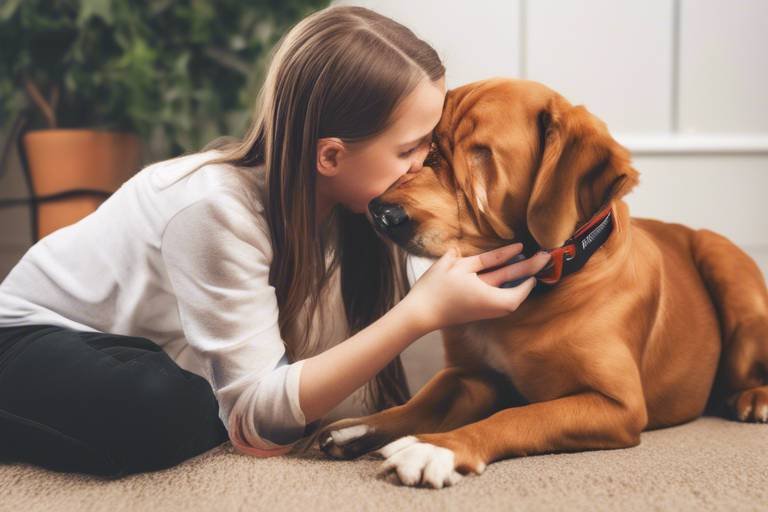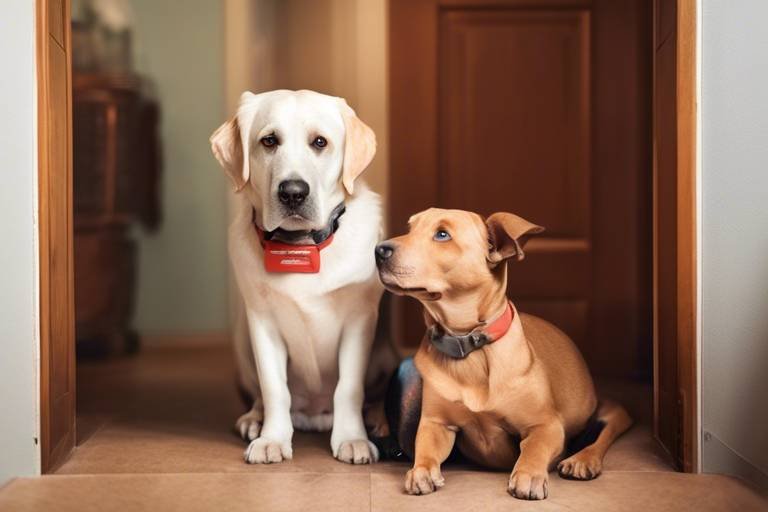How to Help a Shy Rescue Pet Come Out of Their Shell
Bringing a rescue pet into your home can be one of the most rewarding experiences of your life, but it can also come with its own set of challenges, especially if your new furry friend is shy. Just like us, animals have their own personalities, and some might take a little longer to warm up to their new surroundings. In this article, we will explore effective strategies to help your shy rescue pet feel safe, secure, and confident in their new environment. With a little patience and understanding, you can help them blossom into the loving companion you always dreamed of.
Recognizing the signs of shyness in rescue pets is crucial for any new pet owner. You might notice behaviors such as hiding, avoiding eye contact, or even trembling when approached. These actions often stem from past traumas or a lack of socialization. Understanding these behaviors allows you to empathize with your new companion and approach them with the care they need. For instance, a shy dog may cower when someone raises their voice, while a timid cat might dart under the couch at the slightest noise. By identifying these behaviors, you can tailor your approach to make them feel more at ease.
Establishing a secure and comfortable space is vital for shy pets. Think of it as creating a little haven where they can feel safe and start to explore their new world at their own pace. Here are some practical steps to create that nurturing environment:
Designating specific areas in your home where your pet can retreat fosters a sense of security. This could be a cozy corner with a soft bed or a quiet room where they can feel protected from household activities. By providing a safe space, you allow your pet to choose when they want to interact, which can significantly reduce their anxiety. Consider using a crate or a designated room as their sanctuary. Make sure it’s stocked with their favorite toys and blankets, so they associate it with comfort.
Creating quiet zones away from household noise is essential for shy pets to relax. Think about it: if you were in a new place and everything was loud and overwhelming, wouldn’t you want a quiet spot to retreat to? Select locations in your home that are naturally quieter, like a spare bedroom or a corner of the living room away from the TV. Encourage your pet to explore these areas by placing treats or toys there, so they can discover their peaceful retreats on their own.
Incorporating familiar items, such as blankets or toys, can help shy pets feel more secure. Just like a child might cling to a favorite stuffed animal, your furry friend will benefit from having something that smells like home. These comfort items can be a lifeline when they feel scared or anxious. Make sure to wash their blankets or toys with a detergent that doesn’t have a strong scent, as this can help preserve the comforting smell they associate with safety.
Introducing your shy pet to new experiences gradually is essential. Think of socialization as a slow dance rather than a wild party. You wouldn’t throw someone into the middle of a dance floor right away, would you? Start by allowing them to observe new environments from a distance, and slowly encourage them to engage when they feel ready. This could mean inviting friends over one at a time rather than hosting a large gathering. The goal is to create positive associations with new experiences without overwhelming them.
Using positive reinforcement can significantly aid in building trust with a shy pet. This means rewarding them for behaviors you want to encourage, such as coming out of their safe space or approaching you. It’s all about creating a positive feedback loop that helps them feel good about their choices. For example, if your cat ventures out from under the couch, offer a treat or gentle praise. Over time, they’ll learn that exploring leads to good things.
Implementing a reward system helps reinforce positive behavior. This can be as simple as keeping a jar of treats handy and using them when your pet takes brave steps. Consistency is key here; if they get a treat every time they come out, they’ll quickly learn that being brave is worth it. This method not only builds trust but also strengthens your bond with your pet.
Being patient and consistent in your approach is key to helping shy pets thrive. Remember, Rome wasn’t built in a day, and neither will your pet’s confidence be. Maintain a steady routine that includes feeding, playtime, and quiet time. This predictability will help your pet feel secure and understand that they can trust you. Celebrate the small victories, and don’t rush the process. With time, your shy pet will come out of their shell and reveal their true personality.
- How long does it take for a shy rescue pet to adjust? Every pet is different, but it can take anywhere from a few days to several months for a shy rescue pet to adjust to their new home.
- What should I do if my pet is still scared after several weeks? Continue to provide a safe environment and use positive reinforcement. Consider consulting with a veterinarian or animal behaviorist for additional strategies.
- Can I help my pet socialize with other animals? Yes! Gradually introduce them to other pets in a controlled environment, ensuring they feel safe and comfortable.

Understanding Shy Behavior
When you bring a rescue pet into your home, it's essential to understand that their timid behavior often stems from past experiences. Many of these animals have faced trauma, neglect, or abandonment, which can leave them feeling vulnerable and unsure in new environments. Recognizing the signs of shyness is the first step in helping your furry friend gain confidence. Shy pets may exhibit a variety of behaviors, such as hiding, cowering, or avoiding eye contact. These actions can be their way of expressing fear or discomfort in unfamiliar situations.
To truly empathize with your new companion, it's crucial to consider the factors that contribute to their shyness. For instance, a dog that was previously abused might flinch at sudden movements or loud noises, while a cat that was abandoned may prefer to observe from a distance rather than engage. Understanding these behaviors allows you to approach your pet with compassion and patience. It's like trying to decipher a foreign language; once you grasp the nuances, communication becomes much easier.
Here are some common signs of shyness in rescue pets:
- Hiding: Seeking refuge under furniture or in corners.
- Avoidance: Steering clear of people or other pets.
- Body Language: Tucked tails, flattened ears, and lowered heads.
- Vocalizations: Whining, growling, or hissing when approached.
Understanding these behaviors is not just about identifying them; it's about creating a safe space where your pet feels secure enough to express themselves. Think of it as building a bridge of trust. The more you learn about their past and their triggers, the better equipped you will be to help them navigate their new life. Remember, patience is key. Just like a flower takes time to bloom, your shy rescue pet will gradually come out of their shell with your love and support.
In conclusion, recognizing and understanding the shy behaviors of rescue pets is essential for any pet owner. By acknowledging their fears and providing a nurturing environment, you can help your new companion transition into a confident and happy member of your family.

Creating a Safe Environment
When it comes to helping a shy rescue pet, creating a safe environment is absolutely essential. Think of it as crafting a cozy little nest where your new furry friend can feel secure and loved. Just like a shy child needs a comforting space to play and grow, your pet will thrive in a setting that allows them to explore at their own pace. This means you need to pay attention to their needs and make adjustments to your home that cater to their timid nature.
Start by designating specific areas in your home that serve as safe spaces. These are spots where your pet can retreat when they feel overwhelmed or anxious. To set up these safe spaces effectively, consider using a quiet corner in a room, a cozy crate with soft bedding, or even a dedicated room where they can have some alone time. The key is to make these areas inviting and comfortable, so your pet feels like they have a sanctuary to escape to whenever they need it.
Creating a safe space is not just about choosing a location; it’s also about filling it with items that make your pet feel secure. You might want to include a soft bed, some toys, and even a few of your pet’s favorite blankets. These familiar items can work wonders in easing anxiety. Imagine how comforting it feels to curl up in your favorite blanket on a chilly day; your pet will feel the same way in their cozy corner.
It’s also important to create quiet zones away from the hustle and bustle of daily life. Shy pets can become easily startled by loud noises or sudden movements, so finding the right locations for these peaceful retreats is crucial. Consider areas that are away from the main foot traffic of your household, such as a spare bedroom or a quiet corner in the living room. By providing these tranquil spaces, you allow your pet to relax and recharge without the stress of overwhelming stimuli.
Incorporating comfort items into your pet’s safe space can significantly help with their anxiety. Items like blankets, toys, or even an old piece of your clothing can provide a sense of familiarity and warmth. These comfort items act as a bridge, helping your pet transition from the stress of their past life to the safety of their new home. Just like a child clings to a favorite stuffed animal, your pet will find solace in these beloved items, making them feel less alone in their new surroundings.
By creating a nurturing environment filled with safe spaces, quiet zones, and comforting items, you set the foundation for your shy rescue pet to gradually come out of their shell. Remember, patience is key. Allow your pet to explore their new home at their own pace, and soon enough, you’ll see their true personality shine through!
Safe Spaces
Creating for your shy rescue pet is one of the most effective ways to help them feel secure and comfortable in their new environment. Imagine stepping into a room full of strangers—overwhelming, right? That’s exactly how your pet feels when they’re in an unfamiliar setting. By establishing a retreat where they can feel safe, you’re providing them with a sanctuary to recharge and gather their courage.
First and foremost, consider the layout of your home. Look for quiet corners or areas that are less trafficked. These spots should be away from the hustle and bustle of everyday life, like the noise from the television or the sounds of children playing. A cozy nook under a staircase or a corner in a bedroom can serve as the perfect hideaway. You want your pet to have a place where they can observe the world without feeling pressured to engage.
Next, think about the materials that will make this space inviting. A soft bed or a plush blanket can work wonders, providing your pet with comfort and warmth. Incorporating their favorite toys or even a piece of your clothing can offer a familiar scent, which can be incredibly soothing. The goal is to create a space that feels like their very own little fortress, where they can retreat whenever they need a break.
It's also important to remember that should be easily accessible. If your pet feels the need to escape, they shouldn’t have to navigate through obstacles to get to their sanctuary. Keep the area clear and inviting, ensuring that they can retreat there whenever they feel overwhelmed. You might even consider using a pet gate to keep the area designated just for them, which can help them feel more secure.
Lastly, be patient as your shy pet begins to use their safe space. They may not immediately take to it, and that’s perfectly normal. Encourage them gently by spending time nearby, perhaps sitting down with a book or even enjoying a snack. This way, they can associate their safe space with positive experiences and eventually feel comfortable enough to explore it on their own.
Quiet Zones
Creating in your home is an essential step in helping your shy rescue pet feel safe and secure. Just like humans, pets can become overwhelmed by noise and activity, which can lead to increased anxiety and stress. Imagine trying to relax in a bustling café when all you want is a cozy corner to sip your coffee in peace. Your furry friend feels the same way! By designating specific areas in your home that are free from loud noises and distractions, you can provide a sanctuary where they can unwind and recharge.
When setting up these quiet zones, consider locations that are naturally quieter, such as a spare room, a cozy nook under the stairs, or a corner of your living room away from the hustle and bustle. The goal is to create a space that feels inviting and safe. Here are some tips to enhance these areas:
- Choose the Right Location: Look for spots that are away from high traffic areas in your home. This could mean steering clear of places near the front door or busy hallways.
- Use Soft Lighting: Bright lights can be intimidating for shy pets. Opt for soft, warm lighting to create a calm atmosphere.
- Soundproofing: If possible, add rugs or curtains to help absorb sound. These simple changes can make a significant difference.
Once you've identified the perfect spots, it's time to make them feel like home. Consider adding a comfortable bed or blanket that your pet loves. Familiar scents can work wonders in making them feel more at ease. You might also want to include their favorite toys or a safe chew item. This is their little haven, a place where they can retreat when the world feels too overwhelming.
Additionally, it's important to ensure that these quiet zones are accessible at all times. Think of it like having a personal retreat. If your pet knows they can go to their quiet zone whenever they need a break, they are more likely to feel secure in your home. You might even notice them gravitating towards these areas when they need some time alone.
In conclusion, creating quiet zones is a vital aspect of helping your shy rescue pet feel comfortable and confident in their new environment. By providing them with a peaceful retreat, you are not only catering to their needs but also fostering a trusting relationship that can lead to a happier, more social pet in the long run. Remember, patience is key, and every little step you take towards creating a serene space can make a world of difference for your furry friend.
- How do I know if my pet needs a quiet zone? If your pet shows signs of anxiety, such as hiding, excessive barking, or destructive behavior, it may be time to create a quiet zone.
- Can I use a crate as a quiet zone? Yes, a crate can serve as a safe space for your pet, as long as they see it as a positive environment. Make it cozy with blankets and toys.
- How long should my pet stay in their quiet zone? Allow your pet to decide when to leave their quiet zone. They will venture out when they feel comfortable and ready.
Comfort Items
When it comes to helping a shy rescue pet feel at home, play a crucial role. These familiar objects can provide a sense of security and help ease anxiety, acting as a bridge between their past experiences and their new environment. Think of comfort items as the teddy bears of the pet world; they offer a feeling of safety and warmth that can make all the difference in a shy pet's journey toward confidence.
So, what exactly qualifies as a comfort item? Well, it can vary from pet to pet, but generally, you’ll want to consider items that have a soothing effect. For instance, a soft blanket or a favorite toy can be incredibly helpful. These items not only smell familiar but also provide a physical space where the pet can curl up and feel secure. Imagine wrapping yourself in a cozy blanket on a chilly day; that’s the kind of comfort we’re aiming for with our furry friends!
Here are a few types of comfort items that can significantly aid in calming your shy pet:
- Blankets: A soft, warm blanket can serve as a safe haven. Opt for one that carries their scent or has been used in their previous environment.
- Toys: Chew toys or plush toys can provide both comfort and entertainment, helping to distract them from their fears.
- Clothing: Some pets find solace in wearing a snug shirt or sweater, as it can mimic the feeling of being cuddled.
Additionally, it’s important to place these items strategically in your home. Creating a cozy nook with their comfort items can encourage your shy pet to explore and settle in. You might want to set up a designated corner with a comfy bed, a blanket, and a few toys. This not only gives them a space to retreat to when they feel overwhelmed but also encourages them to associate that area with positivity and safety.
Incorporating comfort items into your pet’s routine can significantly enhance their sense of security. As you watch them gradually become more relaxed and confident, you’ll realize just how impactful these simple objects can be. Remember, it’s all about creating a nurturing environment where your shy rescue pet can thrive!
Q: How long does it take for a shy rescue pet to adjust to their new home?
A: Every pet is different, but it can take anywhere from a few days to several weeks for a shy rescue pet to feel comfortable. Patience and understanding are key!
Q: What if my pet shows signs of fear even after a few weeks?
A: If your pet is still showing signs of fear, consider consulting a veterinarian or a professional trainer who specializes in shy or fearful animals. They can provide tailored advice and strategies.
Q: Can I use treats as comfort items?
A: While treats can be a great way to build trust, they are not typically considered comfort items. However, using treats during positive reinforcement training can help your pet associate you and their new environment with good experiences.
Gradual Socialization
Socializing a shy rescue pet is like nurturing a delicate flower; it requires time, patience, and the right conditions to blossom. Just as every flower needs sunlight and water, your pet needs gradual exposure to new experiences to build their confidence. Start small—think of it as introducing a friend to a new group. You wouldn't throw them into the deep end right away, would you? Instead, you ease them into the conversation, allowing them to feel comfortable at their own pace.
One effective way to achieve gradual socialization is through controlled introductions. Begin with short, quiet interactions where your pet feels safe. For instance, invite a calm friend over to meet your pet in a familiar environment. Keep the meeting brief and positive; this way, your pet can associate new people with pleasant experiences. As your pet becomes more comfortable, you can gradually increase the duration and frequency of these interactions.
Another essential aspect of gradual socialization is exposing your pet to various environments and sounds. Start by taking them on short walks around the neighborhood. Remember, the goal is to make these outings enjoyable. If you notice your pet becoming anxious, don't hesitate to retreat back to a quieter area. This teaches them that they can trust you to keep them safe, which is crucial for building their confidence.
To further help your shy pet, consider using positive reinforcement during socialization sessions. Whenever your pet reacts positively to a new experience—be it meeting a new person or exploring a new area—reward them with treats or praise. This not only encourages them to engage with their surroundings but also reinforces the idea that new experiences can be rewarding. Here’s a simple table to illustrate how you can structure these sessions:
| Session Type | Duration | Reward |
|---|---|---|
| Meeting New People | 5-10 minutes | Treats and praise |
| Short Walks | 10-15 minutes | Favorite toy or praise |
| Exploring New Spaces | 5-10 minutes | Calm reassurance and treats |
Lastly, remember that every pet is unique. Some may take to socialization like a duck to water, while others might need a little more coaxing. Be sure to observe your pet's body language. Signs of stress, such as cowering or hiding, indicate that it’s time to slow down. By respecting their boundaries and allowing them to dictate the pace, you’ll create a trusting bond that encourages them to come out of their shell.
In summary, gradual socialization is a journey that requires understanding, patience, and a sprinkle of creativity. By introducing new experiences slowly and positively, you’re not just helping your shy rescue pet adjust; you’re giving them the tools to thrive in their new environment. So take a deep breath, grab some treats, and embark on this beautiful adventure with your furry friend!

Positive Reinforcement Techniques
When it comes to helping a shy rescue pet come out of their shell, positive reinforcement is one of the most effective tools in your toolkit. This approach is based on the simple yet powerful principle that animals, much like humans, respond better to rewards than to punishment. Imagine being in a new, scary environment where everything feels overwhelming; now, think about how much easier it would be if you were rewarded for your bravery! That’s exactly what positive reinforcement does for your furry friend—it encourages them to explore their new world with a little more confidence.
To effectively implement positive reinforcement, you need to understand what motivates your pet. For some, it might be tasty treats, while others may respond better to praise or playtime. The key is to observe and learn what gets their tail wagging or ears perked up. Once you identify these motivators, you can create a tailored reward system that will help your shy pet feel more secure and loved.
Here’s a simple breakdown of how to establish a successful reward system:
| Step | Description |
|---|---|
| 1. Identify Rewards | Discover what your pet loves—treats, toys, or affection. |
| 2. Set Goals | Decide on small, achievable goals for your pet, like exploring a new room. |
| 3. Reward Immediately | Give the reward right after your pet achieves the goal to reinforce the behavior. |
| 4. Be Consistent | Use the same rewards and cues to create a reliable routine. |
Consistency is key in this process. If you reward your pet every time they take a small step towards overcoming their shyness, they will begin to associate those actions with positive outcomes. Just like a child learning to ride a bike, your pet needs that gentle push and encouragement to gain confidence. Remember, it’s not just about the treats; your voice, body language, and presence also play a significant role. A calm and reassuring tone can work wonders in making your pet feel safe.
Moreover, patience is essential. Don’t rush the process; every shy pet has its own pace. Celebrate the little victories, whether it’s a sniff of a new toy or a tentative step into a new room. These moments are monumental for a shy pet and should be acknowledged. You might even find it helpful to keep a journal of your pet’s progress. This way, you can track their achievements and reflect on how far they’ve come—trust me, it’s a rewarding experience!
In conclusion, positive reinforcement is not just a training method; it’s a way to build a deep, trusting relationship with your shy rescue pet. By focusing on rewards, consistency, and patience, you’ll not only help your pet overcome their fears but also strengthen the bond you share. So, grab those treats, speak softly, and watch as your shy companion blossoms into a confident and loving member of your family!
- What is positive reinforcement? It's a training method that rewards desired behaviors to encourage them in the future.
- How long does it take for a shy pet to respond to positive reinforcement? It varies by pet; some may respond quickly, while others may take weeks or months.
- Can I use positive reinforcement with other training methods? Yes! It can be combined with other techniques for even better results.
Reward Systems
Implementing a reward system is one of the most effective ways to encourage positive behavior in your shy rescue pet. Think of it as a way to speak their language, where treats and affection become the keys to unlocking their confidence. Just like we feel motivated to do better when someone praises us, our furry friends thrive on positive reinforcement. So, how can you create a rewarding atmosphere that encourages your pet to come out of their shell?
First, it's essential to identify what motivates your pet the most. For some, it might be their favorite treats, while others may respond better to toys or even verbal praise. This is where a bit of observation comes in handy—spend some time watching what gets your pet excited. Once you know their preferences, you can tailor your reward system accordingly.
Next, consistency is key. Establish a routine where you reward your pet immediately after they exhibit a desired behavior. For instance, if your shy dog approaches you or explores a new area in your home, offer them a treat right away. This immediate feedback helps them make the connection between their actions and the rewards they receive. Over time, this will encourage them to repeat those behaviors, slowly building their confidence.
To keep things organized, consider creating a simple reward chart that tracks your pet's progress. You can use a table format like this:
| Date | Behavior | Reward Given |
|---|---|---|
| 10/01/2023 | Approached owner | Small treat |
| 10/02/2023 | Explored new area | Playtime with toy |
| 10/03/2023 | Responded to name | Verbal praise |
This chart not only helps you keep track of your pet's progress but also serves as a visual reminder of how far they've come. It can be incredibly rewarding for you as an owner to see the transformation in your pet’s behavior over time.
Finally, remember that patience is crucial. Some pets may take longer to respond to a reward system than others. Celebrate the small victories along the way, whether it's a wag of the tail or a hesitant step forward. Each moment of progress is a step closer to building a trusting relationship with your shy rescue pet. So, keep those treats handy, stay consistent, and watch as your furry friend blossoms into a more confident companion!
Q: How long does it take for a shy pet to respond to a reward system?
A: The timeline can vary greatly depending on the individual pet's personality and history. Some may start showing progress within a few days, while others might take weeks or even months. The key is to remain patient and consistent.
Q: What types of rewards work best for shy pets?
A: Every pet is unique, but common rewards include treats, toys, and verbal praise. Experiment with different options to see what your pet responds to best.
Q: Can I use the reward system for training commands as well?
A: Absolutely! The reward system is effective for training commands, socialization, and even desensitization to new experiences. Just ensure that the rewards are immediate and consistent.
Patience and Consistency
When it comes to helping a shy rescue pet come out of their shell, patience and consistency are your best friends. Imagine trying to navigate a new city without a map—overwhelming, right? That’s how your pet might feel in their new home. They need time to adjust to their surroundings, and rushing the process can lead to setbacks. Just like humans, pets have their own unique timelines for adaptation. Some might take a few days, while others may need weeks or even months to feel truly comfortable.
Establishing a routine can work wonders for a shy pet. When they know what to expect, it helps reduce their anxiety. For instance, try feeding them at the same time every day, and stick to a regular schedule for walks and playtime. This predictability creates a sense of security. You might think of it as building a sturdy foundation for a house; without it, everything else might crumble. A consistent routine can include:
- Feeding times
- Play sessions
- Training exercises
- Quiet time
Moreover, when you introduce new experiences, do so in a gradual manner. If you want to introduce them to new people or environments, take baby steps. For example, start with short visits from friends or family members. This way, your pet can slowly acclimate without feeling overwhelmed. Each positive interaction they have will help build their confidence, much like how a child learns to ride a bike. They start with training wheels and gradually progress to riding solo.
Remember, consistency isn’t just about routines; it’s also about your reactions and responses. If your pet shows signs of fear or anxiety, how you respond can either reinforce their fears or help them feel secure. Always respond calmly and positively. If they approach you, even if it’s just a little, reward them with gentle praise or a treat. This method strengthens the bond between you and your furry friend, allowing them to associate good things with being around you.
In summary, patience and consistency are the cornerstones of helping your shy rescue pet feel at home. By creating a stable environment and a predictable routine, you’re not just helping them adjust—you’re building a lasting relationship based on trust and love. So, take a deep breath, embrace the journey, and watch as your timid companion blossoms into a confident, happy pet.
Here are some common questions pet owners have about helping shy rescue pets:
- How long does it take for a shy pet to adjust? Every pet is different, but it can take anywhere from a few days to several months. Patience is key!
- What if my pet never seems to come out of their shell? Some pets may always be a bit shy. Focus on providing a loving environment and seek advice from a professional trainer if needed.
- Can I force my pet to socialize? No, forcing them can lead to more fear. Gradual exposure is essential.
- What are some signs that my pet is becoming more comfortable? Look for relaxed body language, playful behavior, or seeking your attention.
Frequently Asked Questions
- What are the signs that my rescue pet is shy?
Shy pets often exhibit behaviors such as hiding, avoiding eye contact, or cowering when approached. They may also be hesitant to explore their surroundings or interact with people and other pets. Recognizing these signs is the first step in helping them feel more comfortable.
- How can I create a safe environment for my shy pet?
Start by designating a quiet area in your home where your pet can retreat when feeling overwhelmed. Use comfortable bedding, familiar toys, and keep this space free from loud noises and sudden movements. This safe haven will help your pet feel secure and more willing to explore their new surroundings.
- What are some effective ways to socialize a shy pet?
Gradual exposure is key! Begin by introducing your pet to new experiences slowly. Use treats to encourage them to explore and reward them for small steps forward. Avoid forcing interactions; instead, let your pet approach new situations at their own pace.
- How important is positive reinforcement in training a shy pet?
Positive reinforcement is crucial! It helps build trust and encourages your pet to engage in desired behaviors. By rewarding your pet with treats, praise, or playtime when they show confidence, you create a positive association with new experiences.
- How long will it take for my shy pet to adjust?
Every pet is different, so the adjustment period can vary widely. Some may start to show signs of confidence within weeks, while others may take months. Patience is essential; maintaining a consistent routine will help your pet feel more secure over time.
- Can comfort items really help my shy pet?
Absolutely! Familiar items like blankets, toys, or even your clothing can provide a sense of security and comfort for shy pets. These items can help them feel more at home and encourage them to explore their environment.
- What if my shy pet continues to show signs of fear?
If your pet is still fearful after implementing these strategies, consider consulting a veterinarian or a professional animal behaviorist. They can provide tailored advice and strategies to help your pet overcome their anxiety.



















